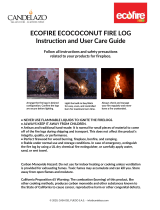
Escape 1800-I Insert Installation and Operation Manual
12
2.4 The Benefits of Low Emissions and High Efficiency
The low smoke emissions produced by the special features inside the Escape 1800-I insert
firebox mean that your household will release up to 90 percent less smoke into the outside
environment than if you used an older conventional stove. But there is more to the emission
control technologies than protecting the environment.
The smoke released from wood when it is heated contains about half of the energy content
of the fuel. By burning the wood completely, your insert releases all the heat energy from
the wood instead of wasting it as smoke up the chimney. Also, the features inside the firebox
allow you to reduce the air supply to control heat output, while maintaining clean and efficient
flaming combustion, which boosts the efficient delivery of heat to your home.
The emission control and advanced combustion features of your insert can only work
properly if your fuel is in the correct moisture content range of 15 to 20 percent. See Section
3 of this manual for suggestions on preparing fuelwood and judging its moisture.
2.5 The SBI Commitment to You and the Environment
The SBI team is committed to protecting the environment, so we do everything we can to
use only materials in our products that will have no lasting negative impact on the
environment.
2.5.1 What is Your New Insert Made Of?
The body of your insert, which is most of its weight, is carbon steel. Should it ever become
necessary many years in the future, almost the entire insert can be recycled into new
products, thus eliminating the need to mine new materials.
The paint coating on your insert is very thin. Its VOC content (Volatile Organic Compounds)
is very low. VOCs can be responsible for smog, so all the paint used during the
manufacturing process meets the latest air quality requirements regarding VOC reduction
or elimination.
The air tubes are stainless steel, which can also be recycled.
Vermiculite is used for the baffle. Vermiculite is a mineral. Large commercial mines exist in
China, Russia, South Africa, and Brazil. Potassium silicate is used as a binder to form a
rigid board. Vermiculite can withstand temperatures above 2,000 °F. It is not considered
hazardous waste. Disposal at a landfill is recommended.
Lightweight firebrick is made of pumice and cement. Pumice is volcanic rock, a naturally
green product found in the Northwest United States. Disposal at a landfill is recommended.
The door and glass gaskets are fibreglass which is spun from melted sand. Black gaskets
have been dipped into a solvent-free solution. Disposal at a landfill is recommended.
The door glass is a 4 mm thick ceramic material that contains no toxic chemicals. It is made
of natural raw materials such as sand and quartz that are combined in such a way to form a
high temperature glass. Ceramic glass cannot be recycled in the same way as normal glass,
so it should not be disposed of with your regular household products. Disposal at a landfill
is recommended.


























